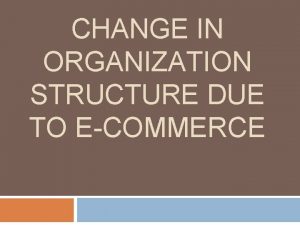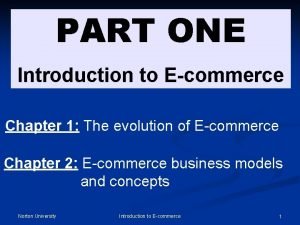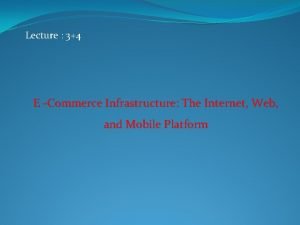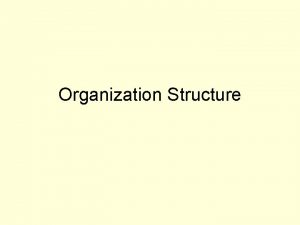CHANGE IN ORGANIZATION STRUCTURE DUE TO ECOMMERCE INTRODUCTION















- Slides: 15

CHANGE IN ORGANIZATION STRUCTURE DUE TO E-COMMERCE

INTRODUCTION There are many organizational structures but they can be simply categorized into being either centralized or decentralized and either tall or flat. The organizational structure reflects how information flows within a company , how tasks are assigned and supervised and the degree of control that top management exercises over the enterprise. It has also reduced the cost inconvenience and time involved in communication within and outside an enterprise.

TRANSFORMING ORGANIZATIONS Here , we look at two key organizational transformations : organizational learning and the nature of work. 1. ORGANIZATIONAL LEARNING: To survive, companies will have to learn and adapt quickly to the new technologies. This struggle will offer them an opportunity to experiment with new products, services and business models, which may lead to strategic and structural changes. These changes may transform the way in which business is done. Thus, new technologies will require new organizational structures and approaches.

2. THE CHANGING NATURE OF WORK The nature of some work and employment will be restructured in the digital age, it is already happening before our eyes. For example, driven by increased competition in the global marketplace, firms are reducing the no. of employees down to a core of essential staff and outsourcing whatever work they can to countries where wages are significantly lower. Digital age workers will have to be very flexible. Few will have truly secure jobs in the traditional sense and many will have to be willing and able to constantly learn, adapt, make decisions and stand by them. The companies will have to view its core of essential workers as its most valuable asset. It will have to constantly nurture them and provide them with every means

REDEFINING ORGANIZATIONS The following are the ways in which e-commerce will redefine organizations. 1. New and improved product capabilities: E-commerce allow for new products to be created and for existing products to be customized in innovative ways. Such changes may redefine organizations missions and the manner in which they operate. Customer profiles, as well as data on consumer preferences can be used for improving products or designing new ones. Mass customization enables manufacturers to create specific products for each customer, based on customer’s exact needs. For e. g. MOTOROLA gathers customer needs for a pager or a cellular phone, transmits the customers specifications electronically to the manufacturing plant where the device is to be manufactured & then sends the finished

2. New business models: E-commerce not only affect individual companies and their products but also entire industries. The wide availability of information and its direct distribution to consumers will lead to the use of new business models (For e. g. - the name-your-own-price model of priceline. com). 3. Impact on Manufacturing: E-commerce is changing manufacturing systems from mass production lines to demand-driven , just-in-time manufacturing. These new production systems are integrated with finance, marketing and other functional systems as well as with business partners and customers. Using these systems, companies can direct customer orders to designers or to production floor within seconds, production cycle time is cut by 50% or more

4. Improving the supply chain : One of the major benefits of e-commerce is the potential improvement in supply chains. A major change is the creation of a hub-based chain.

5. Impacts on Finance and Accounting: E-commerce require special finance and accounting systems. Most notable of these are electronic payment systems. Traditional payment systems are ineffective or inefficient for electronic trade. The use of new payment systems such as electronic cash is complicated because legal issues and agreements on international standards are involved. Electronic cash will change how payments are made and shake the foundations of financial systems. One of the most innovative concepts in accounting and finance is the “virtual close, ” which would allow companies to close their

6. Impact on Human Resources Management and Training: E-commerce is changing how people are recruited, evaluated, promoted and developed. It is also changing the way training and education are offered to employees. online distance learning is exploding, providing opportunities that never existed in the past. Companies are cutting training costs by 50% or more and virtual courses and programs are mushrooming. At the same time, corporations are finding that elearning may be their ticket to survival as changing environments, new technologies and continuously changing procedures make it necessary for employees to be trained and retrained constantly, a process known as e-

Types of e-market places : from storefronts to portals There are several types of e-market places. The major e-marketplaces are storefronts and malls. Let’s elaborate on these as well as on the gateways to e-marketplaces portals.

Electronic Storefronts An electronic or web storefront refers to a single company’s website where products and services are sold. It is an electronic store. The storefront may belong to a manufacturer (example geappliances. com and dell. com) , to a retailer (example walmart. com) to individuals selling from home or to another type of business.

Electronic Malls Similar to malls in the physical world , an emall (online mall) is an online shopping location where many stores are located. For example – hawaii. com is an e-mall that aggregates products and stores in each category. Hawaiian When a consumer indicates the category he or she is interested in , the consumer is transferred to the appropriate independent storefront.

Information Portals A portal is a mechanism that is used in emarket places , e-stores and other types of EC (e. g. – in intra business , e-learning etc. ). Finding relevant and accurate information is often time consuming. One solution to this problem is the use of portals. An information portal is a single point of access through a web browser to critical business information located inside and outside of an organization.

CONCLUSION Companies should expect organizational changes in all functional areas once ecommerce reaches momentum. At a minimum, purchasing will be done differently in many organizations ; introducing models such as forward auctions and affiliate programs may also have a major impact on business operations. Overtime, organizations, individuals and society will reap the full benefits of EC , including those that at present are myths.

THANK YOU
 Rocks change due to temperature and pressure change
Rocks change due to temperature and pressure change Organizational structure of e commerce company
Organizational structure of e commerce company Figura geometrica che ha tutti i lati disuguali
Figura geometrica che ha tutti i lati disuguali Procedural vs substantive due process
Procedural vs substantive due process Slidetodoc
Slidetodoc Due piccole sfere identiche sono sospese
Due piccole sfere identiche sono sospese E commerce and world wide web
E commerce and world wide web Introduction to ecommerce
Introduction to ecommerce Ecommerce infra structure
Ecommerce infra structure Essay structure introduction
Essay structure introduction Material usage variance = material mix variance +
Material usage variance = material mix variance + Process organization in computer organization
Process organization in computer organization Point by point arrangement
Point by point arrangement Internal forces of change in an organization
Internal forces of change in an organization Internal forces of change in an organization
Internal forces of change in an organization Internal forces of change in an organization
Internal forces of change in an organization





























